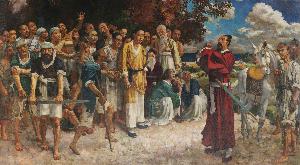Xu Beihong
Xu Beihong
Place: Yixing
Born: 1895
Death: 1953
Biography:
was a renowned Chinese painter born in Yixing, Jiangsu province, in 1895. He is primarily known for his stunning Chinese ink paintings of horses and birds, which reflected the need for artistic expressions that represented a modern China at the beginning of the 20th century.
Early Life and Education
Xu Beihongbegan studying classic Chinese works and calligraphy with his father Xu Dazhang when he was six, and Chinese painting when he was nine. In 1915, he moved to Shanghai, where he made a living off commercial and private work. He travelled to Tokyo in 1917 to study arts, and later to Paris at the École Nationale Supérieure des Beaux-Arts, where he studied oil painting and drawing.
Artistic Career
Xu Beihongwas one of the first Chinese artists to combine traditional Chinese brush and ink techniques with Western perspective and methods of composition. His works, such as The Foolish Old Man Who Removed the Mountains, showcased his mastery of both oils and Chinese ink. As an art teacher, he advocated the subordination of technique to artistic conception and emphasized the importance of the artist's experiences in life. Key aspects of Xu Beihong's artistic style:
- Combination of traditional Chinese techniques with Western methods
- Use of bold brush strokes and precise delineation of form
- Emphasis on artistic conception over technique
Legacy
Xu Beihongenjoyed massive support from art collectors across Asia. His connections with various parts of Asia and Europe opened a new chapter of historical narratives, exchanges, and influences of aesthetics and ideas in art. Many pioneer artists, such as Chen Wen Hsi and Lee Man Fong, looked up to him as a mentor and a worthy peer. To learn more about Xu Beihong and his works, visit the Xu Beihong page on Wikioo.org. You can also explore the categories of oil paintings and photo to painting services offered by Wikioo.org. For more information on Xu Beihong's life and art, check out his Wikipedia page.
Wikipedia link: Click Here














